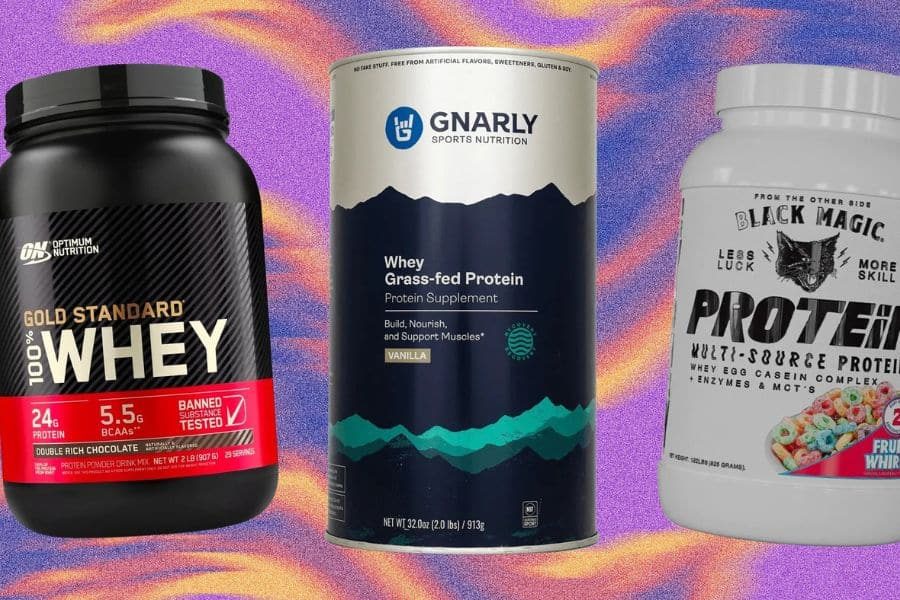Choosing the Right Protein Powder
Picking the right protein powder can turbocharge your muscle-building journey. Knowing the types of protein sources and their perks helps you make a smart choice.
Types of Protein Sources
Protein powders come from all sorts of places, each with its own goodies. Let’s break it down:
- Whey Protein: This milk-based champion has all the good stuff – essential amino acids. It’s easy to digest, perfect for revving you up and zapping stress (Cleveland Clinic).
- Casein Protein: Also from milk, but this one takes its sweet time to digest, making it great for overnight muscle fix-ups.
- Soy Protein: A plant-based superhero that’s good for watching your cholesterol and keeping bones strong (Cleveland Clinic).
- Pea Protein: Perfect for anyone dodging dairy, packed with branched-chain amino acids.
- Egg Protein: Top-tier protein minus the dairy fuss, so it’s a win for the lactose-intolerant crowd.
- Hemp Protein: Loaded with omega-3 and omega-6 fatty acids, it’s a tasty plant-based pick.
Here’s a handy table to compare the protein content in common protein powders:
| Protein Type | Protein Content (g) per Scoop |
|---|---|
| Whey Protein | 20 – 25 |
| Casein Protein | 20 – 25 |
| Soy Protein | 15 – 20 |
| Pea Protein | 15 – 20 |
| Egg Protein | 20 – 25 |
| Hemp Protein | 10 – 15 |
Benefits of Protein Powder
Snagging the right protein powder brings big wins like muscle gain, weight control, and health upgrades:
- Muscle Growth: Perfect for bouncing back after those beastly workouts. More on whey protein’s wonders is just a click away at our whey protein powder benefits article.
- Weight Management: These shakes can keep hunger at bay, which is a plus for losing weight. But remember, pair it with a balanced diet (Cleveland Clinic). Peek at our protein powder for weight loss guide.
- Convenience: Quick and easy to boost your protein intake, ideal for those with jam-packed schedules.
- Nutrient Boost: Some powders throw in extra vitamins and minerals for an added health kick.
For special diet needs, check out protein powder for keto diet, protein powder for seniors, or protein powder without artificial sweeteners.
By getting to know different protein types and their benefits, you can find the perfect protein powder to hit your muscle-building targets and keep your health in top shape.
Whey Protein Overview
So, you’re diving into the protein world to get those muscles popping? Let’s chat about whey protein, a top pick because it’s packed with amino acids and gets to work fast. We’ll break down the basics of whey isolate vs. whey concentrate and why adding whey protein to your workout mix could be your next best move.
Whey Isolate vs. Whey Concentrate
Figuring out the scoop between whey isolate and whey concentrate can really set you up for success in picking the right potion, I mean protein, for muscle growth.
| Type | Protein Content | Lactose Content | Fat Content | Best For |
|---|---|---|---|---|
| Whey Isolate | ≥90% | Really Low | Almost None | Folks avoiding lactose, lean muscle fans |
| Whey Concentrate | 70-80% | Some | A bit more | Muscle builders on a budget |
- Whey Isolate: This stuff goes through extra processing, so it’s loaded with protein (90% or up), barely any lactose, and hardly any fat. Perfect for those dodging lactose and targeting lean muscle.
- Whey Concentrate: Bringing in 70-80% protein with a dash more lactose and fat than isolate. It’s easier on the wallet and perfect for general muscle building.
For more on picking the right protein powder, swing by this nifty article about protein powder for weight loss.
Benefits of Whey Protein for Muscle Building
Whey protein’s got a reputation for boosting muscle growth and helping you bounce back after tough workouts. Here’s why it gets the gold star:
-
Essential Amino Acids: It’s a complete protein, meaning it’s got all the amino acids your body craves for fixing and building muscles. Leucine’s the star player here, firing up muscle gains.
-
Quick Absorption: This protein gets absorbed quicker than you can say “muscle gains,” making it a killer post-workout pick to kickstart muscle protein synthesis (MPS) (Healthline).
-
Muscle Recovery: Regular spoonfuls of whey protein help mend muscles and keep them lean, especially with resistance training (Men’s Health).
To learn more about how whey protein can power you up, dive into our feature on whey protein powder benefits.
Adding whey protein to what you eat can supercharge your muscle-building routine. Whether you pick whey isolate or concentrate, base it on what suits you best. If you’re eyeing other kinds of protein, check out our write-ups on protein powder for women or protein powder for lactose intolerant.
Soy Protein Benefits
Soy protein isn’t just any old protein shake player in the muscle-building game; it’s got some killer perks tucked up its sleeve that’ll make your body say thanks, buddy! Sure, it builds muscle, but it’s got some other tricks you might like!
Cholesterol Wrangler
Feeling guilty about your cholesterol every time you eat cheesy pizza or that double bacon burger? Well, soy protein’s got your back! It’s known for playing the cholesterol cop, keeping those mischievous levels in check. Research dishes out that adding soy to your diet can lower cholesterol and even help your ticker tick for longer (Cleveland Clinic). So, if you’re hunting for a protein powder that promises gains minus the guilt, soy might just be your sidekick.
Fortifying Your Bone Game
Hear a creak? That’s exaggerated, but seriously, bone strength matters, especially as you age. Soy protein does wonders here too, bolstering your bones and giving osteoporosis the boot. This one’s particularly a gem for the ladies and the young-at-heart who are looking at you, calcium (Cleveland Clinic). Sip, shake, or munch on some soy and you might just keep those bones jive-ready.
Let’s put this in a neat little table:
| Benefit | Your Body Thanks You By… |
|---|---|
| Cholesterol Wrangler | Kicking high cholesterol’s butt, heart’s new BFF! |
| Fortifying Your Bone Game | Buffing up bone mass, swatting away osteoporosis worries. |
So what if your body had a little aversion to additives that sound like a chemistry project? There are options. Scout a protein powder with none of the artificial hoopla. Oh, and, if dairy’s ever been your belly’s arch-nemesis, soy protein is your tummy-friendly hero. Dig into more lactose-free protein adventures.
Get soy in your grub and let it flex its muscle magic while it chips in on health duties. Just make sure the powder you pick doesn’t slack off on quality to give you the biggest bang for your muscle-buck!
Understanding Protein Intake
Protein: it’s the building block of life, or so you’ve heard. But figuring out how much of it you actually need and how to sneak it into your day with those powders can be a real head-scratcher. Let’s break it down, from how much protein you should load up on per meal to how those creamy shakes can play a part in shedding some pounds.
Protein Quantity per Meal
Aiming for at least 20 grams of protein per meal works wonders for building muscles (Cleveland Clinic). Of course, you’re not one-size-fits-all; your age, gender, how much you move, and overall health can shift the protein needs meter a bit. Most folks are recommended to stock up 0.8 grams of protein for each kilogram of their body weight (University Health Center, UGA).
Here’s a handy chart for ya:
| Body Weight (lbs) | Daily Protein (g) |
|---|---|
| 110 | 40 |
| 130 | 47 |
| 150 | 54 |
| 170 | 62 |
| 190 | 69 |
| 210 | 76 |
Spread your protein love throughout the day. Aiming for 25-30% of your daily fix in each meal can really help pump up muscle protein synthesis. So, go ahead: sprinkle that protein magic evenly across breakfast, lunch, and dinner.
Protein Shakes for Weight Loss
Got weight-loss goals on your mind? Protein shakes can swoop in to save the day, helping you drop the pounds while holding onto muscle. They’re a quick way to top-up protein without going overboard on calories. Just don’t ditch wholesome foods for shakes all the time, since whole foods tend to come with extra nutrients (Cleveland Clinic).
Ways to incorporate shakes into your routine include:
- Meal Replacement: Some folks swap out a meal with a shake. For more scoop on this, check our piece on protein powder for meal replacement.
- Snack Time: Sipping a shake betwixt meals can curb hunger pangs and keep your hands out of the cookie jar.
| Shake Type | Protein (g) | Calories |
|---|---|---|
| Whey Protein Shake | 25 | 120 |
| Soy Protein Shake | 20 | 110 |
| Casein Protein Shake | 24 | 130 |
Got specific needs or preferences? You’re covered! There’s a mix for protein powder for women, a keto-friendly protein powder, or one that’s free from the usual artificial sweeteners.
Balancing your protein through meals and choosing the right time to throw in a shake is your ticket to hitting those muscle-building and weight-dropping targets. And don’t forget safety first. Sniff out our section on Ensuring Protein Powder Safety before shaking things up.
Best Protein Powders Reviewed
Alright, you’re on the hunt for the perfect muscle-building buddy. We’re diving into the nitty-gritty of three protein powders that are flexing their muscles in the market. Here’s the lowdown on how they stack up so you can snag what’s right for your gains.
Optimum Nutrition Gold Standard 100% Whey Protein Powder
First up, there’s the Optimum Nutrition’s Gold Standard. It’s like the trusty old friend everyone swears by—steady, reliable, and easy on the wallet. With 25 grams of muscle-loving protein and over 2 grams of leucine per scoop, your muscles are in good hands, or scoops! Also, Men’s Health gives it a nod of approval.
Why You Might Love It:
- Jam-packed with protein
- Helps fix muscle tears like a repairman
- Won’t have you breaking the bank
| What’s Inside | What’s It Got |
|---|---|
| Protein per Serving | 25 grams |
| Leucine Content | 2+ grams |
| Flavor Options | Multiple |
| Price (per pound) | $10 – $30 |
Great for mixing in your post-workout shake or adding a boost to your meals. Want to know more about what whey can do? Check our whey protein wonders.
Thorne Research Whey Protein Isolate
Then there’s Thorne Research’s Whey Protein Isolate. Think smooth, and creamy with just plant-sweetness, and you’ve got what’s in this package. It’s packed with 21 grams of pure protein goodness. According to Men’s Health, it’s primo for getting those gains without the extra junk.
Why You Might Love It:
- Sweetens with nature’s touch
- Pure as fresh snow
- Smooth like a jazz tune
| What’s Inside | What’s It Got |
|---|---|
| Protein per Serving | 21 grams |
| Sweeteners | Plant-derived |
| Consistency | Velvety & thick |
| Price (per pound) | $20 – $40 |
Looking for something lean and mean? Thorne’s your pick, especially if keto’s your thing—check it out in our keto-friendly protein picks.
Momentous Essential Protein Powder
Finally, meet the MVP: Momentous Essential Protein Powder. This one is the athlete’s choice, with milk from pampered, grass-fed cows. Clocking in at over 90% protein, you’re basically getting the purest power for your punch. Healthline also gives it a thumbs-up for sticking to high-quality standards.
Why You Might Love It:
- Top-notch whey from grass-grazers
- Almost pure protein rocket fuel
- Loads of badges proving it’s top quality
| What’s Inside | What’s It Got |
|---|---|
| Protein per Serving | More than 90% by weight |
| Source | Grass-fed cows |
| Certifications | NSF Certified, Informed Sport |
| Price (per pound) | $30 – $50 |
When only the best will cut it for your muscle mission, Momentous is the beast. Perfect for those chasing athletic excellence.
Still hungry for more info on protein wonders? Check our all-you-need-to-know articles on protein powder for shedding pounds and meal-replacement masterclasses.
Whey vs. Casein Protein
Getting the 411 on the differences between whey and casein is like choosing between a sports car or a comfy cruiser for your muscle journey. Each has its perks. Picking the right one can give your muscles the VIP treatment and help you flex some serious strength.
Absorption Speed and Mechanism
Alright, here’s the deal with whey protein. It’s the speedster of the protein world, zooming into action in about 20 minutes. That’s super handy when you’re wrapping up a workout and need that muscle magic (WebMD).
Casein is the reliable tortoise in this race. It chills in your stomach, hanging out and popping amino acids over several hours. Perfect for when you’re settling in for that beauty sleep or need to keep your muscles happy during long stretches without grub.
| Protein Type | Absorption Speed | Best Timing |
|---|---|---|
| Whey Protein | Fast and furious (20 mins) | After you work out |
| Casein Protein | Slow and steady (hours) | Nighttime or if you’re skipping lunch |
Muscle Growth and Protein Synthesis
Whey’s the go-to guy for muscle protein synthesis, especially if you’re chowing down around workout time. It’s packed with BCAAs, like leucine, which are basically like throwing a barbecue for your muscles – they love it! The buzz is that whey is top choice for folks lifting heavy and recovering fast (Healthline).
Casein’s no slouch though. It’s got that slow-release vibe, keeping you fueled longer. Great for avoiding your muscles sneaking away their gains when you’re not looking, especially overnight.
| Protein Type | Key Benefit | Muscle Protein Synthesis |
|---|---|---|
| Whey Protein | Quick fixes | High five for high synthesis |
| Casein Protein | Keep the tank full | Medium, but mighty in the long haul |
At the end of the day, the real MVP for muscle growth is eating enough protein overall. Both whey and casein deliver those essential aminos your muscles are hungry for. Mix it up to match your routines and what tickles your tastebuds. Use whey for those heavy sweat sessions and casein for the downtime gaps or as a treat before bedtime.
If you’re curious for more about what powders can do, check out our stuff on protein powder for seniors, protein powder for women, and protein powder for weight loss.
Ensuring Protein Powder Safety
When picking out protein powder to bulk up, you’ve got to be sure it’s safe and free from weird nasties. Here’s how you do it: focus on third-party checkmarks and dodging those pesky contaminants.
Why Third-party Certification Matters
Having a third-party seal is like putting your protein powder through a lie detector test. They’ve gone and had it inspected by someone who isn’t biased, making sure it’s saying the truth on the label and free from dodgy stuff. It means the product holds up to tough standards.
Some of the seals you’ll wanna see include:
- NSF Certified for Sport
- Informed-Sport
- ConsumerLab
These badges mean the product’s been put through the wringer to check for banned stuff, metals that could weigh you down, and pesky pesticides. Spotting these on your protein powder can let you breathe easy knowing you’re not gulping down something sketchy.
Swatting Away Protein Powder Contaminants
Protein powders can have junk you don’t want sneaking into your shaker cup. We’re talking metals like lead, arsenic, cadmium, and mercury. Plus, you might get a sprinkle of bisphenol-A (BPA), those pesticide nasties, or other baddies. Harvard Health Publishing spilled the beans that some protein powder once had 25 times too much BPA. Yikes!
List of Common Party Crashers
| Contaminant | Where’s It Coming From? | Bad Vibes |
|---|---|---|
| Heavy Metals (Lead, Arsenic, Cadmium, Mercury) | Dirty dirt, sketchy production | Cancer, messed-up organs |
| Bisphenol-A (BPA) | Plastic stuff | Hormone havoc |
| Pesticides | Not-organic everything | Loads of health troubles |
To dodge these unwelcomed guests, go for trusted brands that let you in on where they get their stuff and how they make it. Also, think about getting your protein from actual food when you can. We’re talking nuts, seeds, dairy, beans, fish, chicken, eggs, and lean cuts (Harvard Health Publishing).
For other tips on snatching safe protein powder or swapping it out, check out lines like protein powder without fake sweeteners or protein powder you can eat instead of meals right here on our blog.










